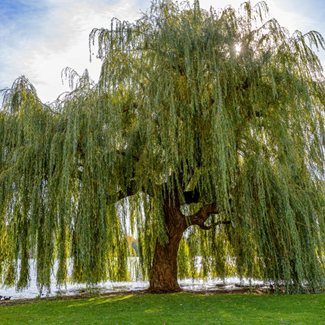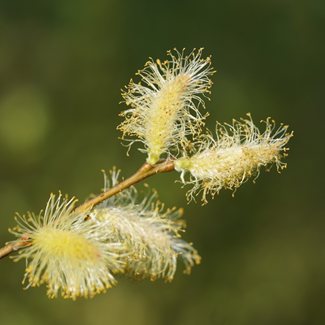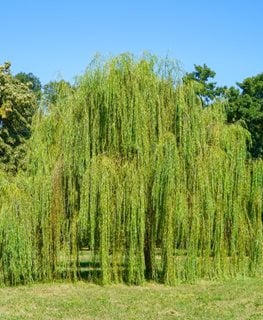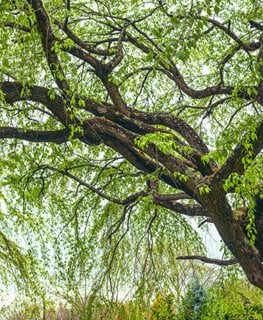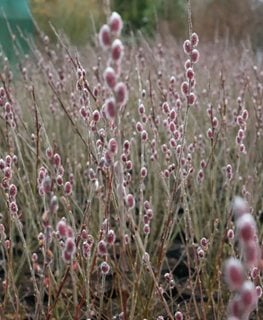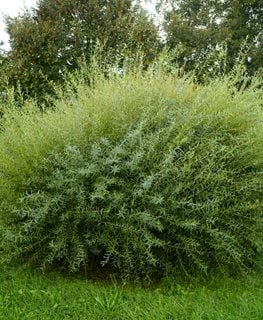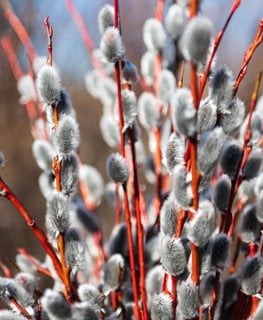WILLOW TREE: VARIETIES, GROWING TIPS & CARE
Learn how to grow and use this versatile landscape plantWillow (Salix) is a diverse group of trees and shrubs, with some 350 willow species native to cold and temperate regions in the Northern Hemisphere. These fast-growing moisture lovers are commonly found along stream banks, ponds, wetlands, and flood plains. Though they can be short-lived, willows have been cultivated and used by humans for thousands of years, for medicinal remedies, weaving, manufacturing, and ornamental value.
Willows can range from small shrubs to towering trees. Weeping willow has timeless appeal and classic elegance as a dramatic focal point along a stream or pond, while the decorative stems of pussy willows are popular in cut floral arrangements. When properly selected, sited, and grown, willows can be effectively used in the landscape. Here’s how to grow willow trees, along with the best varieties and how use them in your yard.
On this page: Basics | Planting | Care & Pruning | Varieties | Problems | FAQs | Landscaping Ideas
On this page:
- BASICS
- PLANTING WILLOW TREES
- WILLOW TREE CARE & PRUNING
- WILLOW TREE VARIETIES
- WILLOW TREE PROBLEMS
- FREQUENTLY ASKED QUESTIONS
- LANDSCAPING IDEAS
WILLOW TREE BASICS
Botanical name:
Salix spp.
Common names:
Willow, with common names for different species
Plant type:
Deciduous tree or shrub
Zones:
2-9
Exposure:
Full sun to partial shade
Habit:
Upright spreading or weeping habit
Size:
4 to 80 feet tall, 4 to 70 feet wide
Bloom time:
Early spring
Flowers:
Most willows are dioecious, with male and female flowers occurring on separate plants. Male flowers produce pollen, while female flowers contain seeds. The small oblong flowers, known as catkins, emerge in early spring before the foliage. Catkins have a wooly texture, with silver, grey, white, black, pink, red, yellow, or chartreuse coloring. Pussy willows and other types are valued for the cut stems that are used in floral arrangements.
Foliage:
Rounded or slender pointed leaves have serrated edges, occurring in colors of green, blue-green, gold, or variegated. Fall color is yellow or yellow-green.
Branches:
Upright, weeping, straight, curved, or twisted branches and stems can be brown, black, red, purple, or yellow. Pussy willow and other types are cut when plants are in the bud stage for early-season arrangements. Stems can be easily rooted from cuttings. Young flexible branches are used for weaving to make baskets, wreaths, fencing, trellises, furniture, and other structures.
PLANTING WILLOW TREES
When to plant:
The best time to plant willow is during cooler months in spring or fall. Wait until all danger of frost is past. In fall, plant at least 6 weeks before your average first frost to allow roots to become established.
Where to plant:
Salix does best with at least 6 hours of full sun per day and damp, well-drained soil. Choose a site near a water source and well away from structures to avoid damage from roots. Allow enough room for the full mature size.
How to plant:
Loosen soil in the planting area and amend if necessary to improve drainage. Dig a hole twice as wide and the same depth as the root ball. Remove plant from its container and tease out roots if potbound. Place in the hole so the top of the root ball is level with the surrounding soil. Fill in the hole and gently tamp down to remove air pockets. Water plants well. Plants can be mulched with a thin layer of bark or other organic matter to retain moisture and suppress weeds.
WILLOW CARE & PRUNING
Soil:
Salix are tolerant of a range of soils, performing best in amended well-draining soil with a pH between 6.0-8.0.
Watering:
These plants are native to swamps, riverbanks, and other moist areas. When growing willow trees, provide regular water. Plants don’t like to dry out. Some varieties are more drought tolerant once established. Plant in a sunny moist area of the yard, or create a rain garden where plants can thrive. In dry spells, willows may shed many leaves in June. Jim Putnam of Hortube notes, "You can lose over half the leaves in a single shot." He advises gardeners to keep an eye on soil moisture and water deeply if needed.
Amendments & fertilizer:
Willow trees grow quickly and are well-adapted to average soils, needing little or no supplemental amendments or fertilizer.
Pruning:
Willows can be pruned in late winter or early spring before plants break dormancy. When tree forms are young, prune plants to develop a strong central leader. Thin out crowded branches to improve air circulation and lightly shape as needed.
For smaller shrubs such as pussy willow, remove up to one third of the growth back to the base of the plant. Cut out small side shoots, crossing or crowded branches to thin the canopy and improve air circulation. Remove top growth to a few feet off the ground so that stems are low enough to harvest for floral arrangements the following spring. These smaller shrubs can be cut back to the ground every few years to maintain a more manageable size.
In this video, Laura LeBoutillier of Garden Answer recommends starting with the deadwood, then work your way into shaping. "You don't have to prune everything, just enough to keep it from getting out of control."
Diseases and pests:
Willows are susceptible to a number of pests and diseases. Pests include aphids, bark beetle, caterpillars, gall mites, leafminer, scale, spider mites, stem borers, willow leaf beetle, and willow sawfly.
Diseases include anthracnose, black canker, blight, crown gall, leaf spot, powdery mildew, root rot, rust, or scab.
Toxicity:
Willow trees are not toxic to humans or pets, though ingestion of any part of the plant may cause mild stomach upset.
WILLOW TREE VARIETIES
WILLOW TREE PROBLEMS
Despite its beauty, willows are known as a high-maintenance plant with a few potential problems to consider.
- Soft wood: Willows have soft, weak wood that is susceptible to breakage, especially during winter snow and ice events.
- Shallow roots: The shallow spreading root system can cause damage to sewer lines, water pipes, sidewalks, and building foundations if plants are sited too closely.
- Messy: Willows generate litter from fallen leaves and branches, requiring regular cleanup.
- Pests and diseases: Plants can be susceptible to a number of pests and diseases.
FREQUENTLY ASKED QUESTIONS
Are willow trees good for small yards?
Willow trees are a challenge to grow in smaller spaces due to their fast growth rate and full mature size. These trees or shrubs develop an extensive root system that can damage home foundations, sidewalks, and pipes. Shrub types such as pussy willow and dappled willow are more suited to smaller yards.
How fast do willow trees grow?
Willows are fast growing plants, adding 3 to 10 feet of new growth in a single growing season, depending on the species.
Are willows invasive?
These plants have an aggressive growth habit and extensive root system that may compete with native species.
Do willow trees lose their leaves in winter?
Willow is a deciduous plant that loses its foliage at the end of the growing season.
Do willow trees need a lot of water?
Willows are found growing in moist soil or near water features, needing regular water to thrive. They require moderate to high amounts of water and don’t like their roots to dry out.
WILLOW TREE LANDSCAPING TIPS
For borders and landscapes:
Plant near a water feature, rain garden, in a native landscape, or allow to naturalize.
For slopes and hillsides:
Willows are effective for controlling erosion along a slope or hillside due to their extensive root system.
For containers:
Willows are not generally recommended to grow in containers due to their extensive root system and mature size. Some dwarf varieties may survive in a large pot and with regular pruning.
When landscaping with ornamental willow trees, it’s essential to select the right variety for the site. Some types of willows are not suitable for smaller yards. Here are some ideas on how to use willows in your landscape.
- Plant a shrub willow in a row as hedging or a wind break.
- Use willow trees for wet soil where many other plants won’t grow.
- Plant willow shrubs along a property line as a living fence or privacy screen.
- Create a rain garden and include smaller willows alongside other water-loving plants.
- Use a bigger tree type such as weeping willow as a stunning focal point along a pond, siting it where the tree is reflected in the water.
- Plant a willow tree as a quick solution to provide shade.
- Include a willow variety with colorful stems for winter interest.
- Place a dwarf weeping willow as a focal point in a bed or border as a structural element.
- Mass a smaller shrub type along a slope to help stem erosion.
- Include small- to medium-sized native varieties in a wildlife landscape to support birds, pollinators, and beneficial insects.
Companion plants: Grow willows alongside other plants that thrive in the same growing conditions of full sun and moist soil. Choose smaller willow varieties with less extensive root systems that won’t compete with other plants for water and nutrients. Good companions for willows include ajuga, astilbe, canna lily, Egyptian papyrus, hydrangea, Japanese iris, meadow rue, spruce, and viburnum.
ABOUT THE AUTHOR
Janet Loughrey is a veteran garden writer and photographer with over 25 years of experience, contributing to major publications like Garden Design, Better Homes and Gardens, and Sunset. A former Master Gardener, she brings hands-on expertise from gardening in a wide range of climates, from upstate New York to the Pacific Northwest.
RELATED:
Flowering Trees for Residential Gardens
Best Small Trees to Grow
